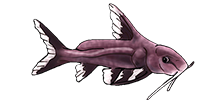Wang, H., Duan, G. and Zhou, H., 2024. Genetic diversity of three consecutive selective breeding generations in Pseudobagrus vachellii (Actinopterygii: Siluriformes: Bagridae). Acta Ichthyologica et Piscatoria, 54, pp.13-20.
https://doi.org/10.3897/aiep.54.105627
Pdf: https://aiep.pensoft.net/article/105627/download/pdf/
Keywords: genetic diversity, genetic structure, microsatellites, Pseudobagrus vachellii, selective breedingAbstract
Pseudobagrus vachellii (Richardson, 1846) is a commercially important freshwater fish species in China. To understand the
effects of artificial breeding on the genetic diversity of three consecutive P. vachellii breeding populations (F1, F2, and F3) since
2012, a genetic analysis was conducted using polymorphic microsatellite markers. The mean allele number, expected hetero-
zygosity, observed heterozygosity, and the polymorphic information content from generation F1 to F3 decreased from 7.75 to
5.63, from 0.77 to 0.63, from 0.83 to 0.77, and from 0.72 to 0.58, respectively. Analysis of molecular variance showed greater
genetic divergence within the three generations (93.67%) than that among the generations (6.33%), and the overall differentia-
tion level was moderate. Additionally, the lowest genetic differentiation was between F2 and F3 (Fst = 0.0484), and the highest
was between F1 and F3 (Fst = 0.12864). Inbreeding occurred in each generation and was the highest in generation F3. Structural
analysis showed that the three P. vachellii generations were most likely divided into two different genetic clusters. Although
genetic diversity declined slightly in the mass selection lines after three breeding generations, overall genetic diversity was
maintained at a relatively high level. To minimize the loss of genetic diversity and inbreeding in the subsequent breeding pro-
cess, a moderate number of parents can be used for each generation. Information regarding the genetic diversity and structure
of the selective P. vachellii breeding generations obtained in this study will be useful for future broodstock management and
selective breeding programs.





